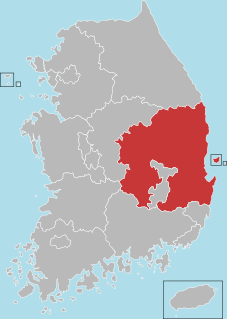
North Gyeongsang Province, also known as Gyeongbuk, is a province in eastern South Korea. The province was formed in 1896 from the northern half of the former Gyeongsang province, remained a province of Korea until the country's division in 1945, then became part of South Korea.

Yeongyang County (Yeongyang-gun) is an inland county in the north-eastern area of North Gyeongsang Province, South Korea.
Deokhangsan is a mountain in the city of Samcheok, Gangwon-do in South Korea. It has an elevation of 1,070.7 m (3,513 ft).
Eungbongsan is a mountain that sits on the border Samcheok, Gangwon-do and Uljin County, Gyeongsangbuk-do, in South Korea. It has an elevation of 999 m (3,278 ft).
Geomunsan is a mountain in the county of Pyeongchang, Gangwon-do, in South Korea. It has an elevation of 1,175 m (3,855 ft).
Daeyasan is a mountain of South Korea. It has an elevation of 931 metres
Geumsusan is a mountain of Chungcheongbuk-do, South Korea. It has an elevation of 1,016 metres.
Gubyeongsan is a mountain of Chungcheongbuk-do, South Korea. It has an elevation of 876 metres.
Hwangaksan is a mountain of South Korea. It has an elevation of 1,111 metres.
Dongaksan is a mountain of Jeollanam-do, western South Korea. It has an elevation of 745 metres.
Geumjeonsan is a mountain of Jeollanam-do, southwestern South Korea. It has an elevation of 668 metres.
Danseoksan is a mountain of Gyeongsangbuk-do, eastern South Korea. It has an elevation of 827 metres.

Geumosan is a mountain of Gyeongsangbuk-do, eastern South Korea. It has an elevation of 977 metres.
Gongdeoksan is a mountain of Gyeongsangbuk-do, eastern South Korea. It has an elevation of 913 metres.
Naeyeonsan is a mountain of Gyeongsangbuk-do, eastern South Korea. It has an elevation of 710 metres.
Unmunsan is a mountain of Gyeongsangbuk-do, eastern South Korea. It has an elevation of 1,195 metres. It is part of the Yeongnam Alps mountain range.
Cheonseongsan is a mountain of Gyeongsangnam-do, southeastern South Korea. It has an elevation of 812 metres.
Wonhyosan is a mountain of Gyeongsangnam-do, southeastern South Korea. It has an elevation of 922 metres.
Yeonil is a town, or eup in Nam-gu, Pohang, North Gyeongsang Province, South Korea. The township Yeonil-myeon was upgraded to the town Yeonil-eup in 1980. Yeonil Town Office is located in Geojeong-ri.
Heunghae is a town, or eup in Buk-gu, Pohang, North Gyeongsang Province, South Korea. The township Uichang-myeon was upgraded to the town Uichang-eup in 1980, and it was renamed Heunghae-eup in 1983. Heunghae Town Office is located in Okseong-ri.




